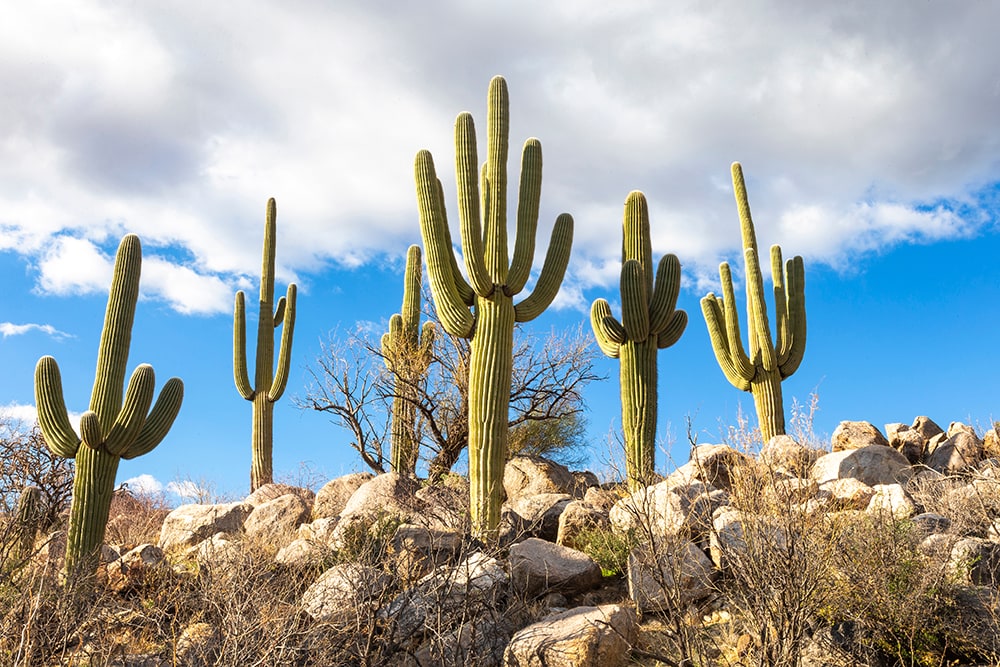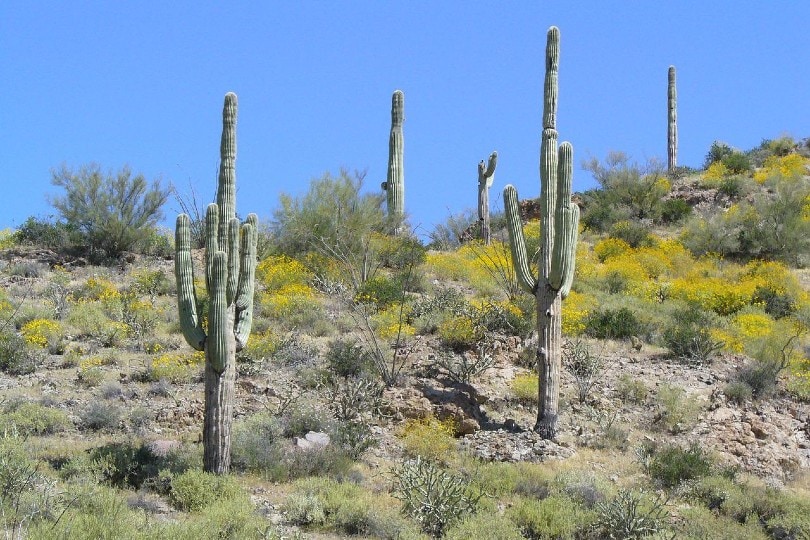Where Do Saguaro Cactus Grow? Facts, Habitat, & Ecological Threats
-
Chris Dinesen Rogers
- Last updated:

Few plants have the same sense of place the Saguaro Cactus (Carnegiea gigantea) has. Just the thought of it will transport you to the American Southwest with visions of this iconic species. It’s unique in many ways. It’s the only of its genus, and what a name it is! If you think it sounds familiar, you’re probably right. German-American botanist George Engelmann named the cactus after philanthropist Andrew Carnegie.
The Saguaro Cactus is what scientists call a keystone species. The term describes organisms that are integral to the workings and survival of an ecological community. Over 100 insect, bird, reptile, and mammal species rely on this plant, whether for food, shelter, or other necessary people.
- Red-tailed Hawk
- Gila Woodpecker
- Great Horned Owl
- Coyote
- Cactus Mouse
- Desert Iguana
- Honeybee
Description of the Saguaro Cactus
Understanding the biology of the Saguaro Cactus gives us a clearer picture of its place in the ecosystem and the areas where it grows. It is a succulent species, meaning it has fleshy stems and arms that allow it to store water. It’s an effective evolutionary strategy, considering where it lives. The cactus can grow 50 feet or more. That explains its species name, gigantea. It’s the largest of its type in the United States.
The Saguaro Cactus is one of the few species to have a taproot, presumably to keep it anchored in the ground. It has large, white blooms that can get as big as 4 inches across. Bees and various bird and bat species are pollinators. It also produces red, edible fruits that many wildlife species readily feed on when they’re ripe.
The cactus is drought tolerant and can handle less than ideal conditions. It has an interesting structural feature that allows it to optimize moisture absorption when it does rain in its arid habitat. Long pleats down its length enable it to expand to capture water, not unlike an accordion. When filled to capacity, a large specimen can tip that scale at over 6 tons.
The Saguaro Cactus grows quite slowly, like many similar species. It is also remarkably long-lived, with some plants reaching up to 200 years. That puts it in the ballpark of many deciduous and coniferous trees. That fact adds to its importance in the ecosystem by providing a long-term, reliable source of food and shelter.

Geographic Range
The Saguaro Cactus is native to Mexico and the United States, with wild populations mainly in Arizona in the Sonoran Desert. The California Depart of Fish and Wildlife has confirmed only 30 cacti in the state. While its numbers are decreasing, the International Union for Conservation of Nature and Natural Resources (IUCN) lists it as a species of least concern.
The cactus can do well as a potted plant in USDA Plant Hardiness Zone 8a, which coincides with its geographic range. Make sure that the container and the soil are well-draining to avoid root rot.
Habitat
You’ll find the Saguaro Cactus growing in shrublands and desert scrub. These arid places pose significant environmental challenges. Of course, moisture looms high on the list. This species has both a long taproot and shallow roots to collect as much water as possible when available. These habitats typically have high evaporation rates and wide daily temperature shifts.
Consequently, most physiological activity takes place at night for the Saguaro Cactus and similar plant species. Gas and moisture exchange takes place when it’s cooler to save this precious resource. The soil is primarily sand, allowing for adequate drainage and airflow. The lack of precipitation means higher concentrations of minerals and salts contribute to the formation of hardpans or a caliche layer.
Ecological Threats and Status
While the Saguaro Cactus isn’t threatened or endangered, the decline in its number is troubling, given its environmental significance. Several factors work against its long-term survival without intervention. While it can grow from seeds, the cactus must reach 30 years or more before it produces fruit.
Although it can tolerate drought, the Saguaro Cactus isn’t a match for fire. It’s a double-edged sword. Fires are a part of the ecology of these habitats. Suppressing them because of the presence of people sets up the perfect storm for catastrophic wildfires. The cactus also damages easily, adding another strike against it.
- Livestock farming
- Development
- Invasive species
- Illegal collection
Fortunately, the state of Arizona has stepped up to protect the Saguaro Cactus and other species with its Native Plant Rules. It’s fair to say that the Grand Canyon State takes its stewardship role seriously, with a lengthy set of regulations covering landowner rights, removal, and transport—heaven forbid if you try to steal or destroy one. You can receive a class 4 felony and a hefty fine for your trouble.
Final Thoughts
The Saguaro Cactus stands as a symbol of the American Southwest. The fact that its population is so small makes it even more special and worthy of the protections bestowed upon it. The key takeaway is that it’s more than its aesthetic value. These plants are critical elements of the environment, providing a vital lifeline for many species. That makes them priceless wherever they occur.
- https://www.lindahall.org/about/news/scientist-of-the-day/george-engelmann
- https://dbg.org/five-interesting-facts-about-saguaros/
- https://www.britannica.com/science/keystone-species
- https://www.cell.com/current-biology/fulltext/S0960-9822(17)30290-7?_returnURL=https%3A%2F%2Flinkinghub.elsevier.com%2Fretrieve%2Fpii%2FS0960982217302907%3Fshowall%3Dtrue
- https://garden.org/plants/view/80803/Saguaro-Carnegiea-gigantea/
- https://www.nps.gov/sagu/learn/nature/why_pleated.htm
- https://www.desertmuseum.org/kids/oz/long-fact-sheets/Saguaro%20Cactus.php
- https://wildlife.ca.gov/Data/CNDDB/News/taxon-of-the-week-the-saguaro-cactus
- https://www.iucnredlist.org/species/152495/121476885
- https://planthardiness.ars.usda.gov/
- https://sciencing.com/landforms-savanna-8542928.html
- https://www.azcentral.com/story/news/local/mesa/2021/02/23/illegal-cut-down-saguaro-cactu
- https://agriculture.az.gov/sites/default/files/Native%20Plant%20Rules%20-%20AZ%20Dept%20of%20Ag.pdfs-arizona/4512887001/
Featured Image Credit: Danita Delimont, Shutterstock
Contents
